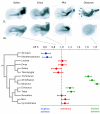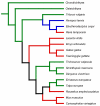Forelimb-hindlimb developmental timing changes across tetrapod phylogeny
- PMID: 17908305
- PMCID: PMC2194785
- DOI: 10.1186/1471-2148-7-182
Forelimb-hindlimb developmental timing changes across tetrapod phylogeny
Abstract
Background: Tetrapods exhibit great diversity in limb structures among species and also between forelimbs and hindlimbs within species, diversity which frequently correlates with locomotor modes and life history. We aim to examine the potential relation of changes in developmental timing (heterochrony) to the origin of limb morphological diversity in an explicit comparative and quantitative framework. In particular, we studied the relative time sequence of development of the forelimbs versus the hindlimbs in 138 embryos of 14 tetrapod species spanning a diverse taxonomic, ecomorphological and life-history breadth. Whole-mounts and histological sections were used to code the appearance of 10 developmental events comprising landmarks of development from the early bud stage to late chondrogenesis in the forelimb and the corresponding serial homologues in the hindlimb.
Results: An overall pattern of change across tetrapods can be discerned and appears to be relatively clade-specific. In the primitive condition, as seen in Chondrichthyes and Osteichthyes, the forelimb/pectoral fin develops earlier than the hindlimb/pelvic fin. This pattern is either retained or re-evolved in eulipotyphlan insectivores (= shrews, moles, hedgehogs, and solenodons) and taken to its extreme in marsupials. Although exceptions are known, the two anurans we examined reversed the pattern and displayed a significant advance in hindlimb development. All other species examined, including a bat with its greatly enlarged forelimbs modified as wings in the adult, showed near synchrony in the development of the fore and hindlimbs.
Conclusion: Major heterochronic changes in early limb development and chondrogenesis were absent within major clades except Lissamphibia, and their presence across vertebrate phylogeny are not easily correlated with adaptive phenomena related to morphological differences in the adult fore- and hindlimbs. The apparently conservative nature of this trait means that changes in chondrogenetic patterns may serve as useful phylogenetic characters at higher taxonomic levels in tetrapods. Our results highlight the more important role generally played by allometric heterochrony in this instance to shape adult morphology.
Figures


Similar articles
-
New, puzzling insights from comparative myological studies on the old and unsolved forelimb/hindlimb enigma.Biol Rev Camb Philos Soc. 2013 Feb;88(1):196-214. doi: 10.1111/j.1469-185X.2012.00247.x. Epub 2012 Sep 7. Biol Rev Camb Philos Soc. 2013. PMID: 22958734 Review.
-
Heterochrony in limb evolution: developmental mechanisms and natural selection.J Exp Zool B Mol Dev Evol. 2009 Sep 15;312(6):639-64. doi: 10.1002/jez.b.21250. J Exp Zool B Mol Dev Evol. 2009. PMID: 19130597
-
Comparative anatomy and development of pectoral and pelvic girdles in hylid anurans.J Morphol. 2018 Jul;279(7):904-924. doi: 10.1002/jmor.20820. Epub 2018 Apr 17. J Morphol. 2018. PMID: 29665044
-
On the serial homology of the pectoral and pelvic girdles of tetrapods.Evolution. 2015 Oct;69(10):2543-55. doi: 10.1111/evo.12773. Epub 2015 Oct 5. Evolution. 2015. PMID: 26374500
-
The evolutionary history of the development of the pelvic fin/hindlimb.J Anat. 2013 Jan;222(1):114-33. doi: 10.1111/j.1469-7580.2012.01557.x. Epub 2012 Aug 23. J Anat. 2013. PMID: 22913749 Free PMC article. Review.
Cited by
-
Evolution of sexual dimorphism in the digit ratio 2D:4D--relationships with body size and microhabitat use in iguanian lizards.PLoS One. 2011;6(12):e28465. doi: 10.1371/journal.pone.0028465. Epub 2011 Dec 5. PLoS One. 2011. PMID: 22162772 Free PMC article.
-
Timing of organogenesis underscores the evolution of neonatal life histories and powered flight in bats.Proc Biol Sci. 2023 Jan 11;290(1990):20221928. doi: 10.1098/rspb.2022.1928. Epub 2023 Jan 11. Proc Biol Sci. 2023. PMID: 36629110 Free PMC article.
-
Sesamoids in Caudata and Gymnophiona (Lissamphibia): absences and evidence.PeerJ. 2020 Dec 18;8:e10595. doi: 10.7717/peerj.10595. eCollection 2020. PeerJ. 2020. PMID: 33384907 Free PMC article.
-
Evolution of eumalacostracan development-new insights into loss and reacquisition of larval stages revealed by heterochrony analysis.Evodevo. 2015 Mar 11;6:4. doi: 10.1186/2041-9139-6-4. eCollection 2015. Evodevo. 2015. PMID: 25973168 Free PMC article.
-
Variation and Variability in Skeletal Ossification of the Gray Short-tailed Opossum, Monodelphis domestica.Integr Org Biol. 2024 Jul 3;6(1):obae024. doi: 10.1093/iob/obae024. eCollection 2024. Integr Org Biol. 2024. PMID: 39114377 Free PMC article.
References
-
- Huxley JS. Problems of relative growth. London: Methuen; 1932.
-
- Polly PD. Limbs in mammalian evolution. In: Hall BK, editor. Fins into Limbs: Evolution, Development and Transformation. Chicago: University of Chicago Press; 2007.
-
- Gould SJ. Ontogeny and Phylogeny. Cambridge, MA: Belknap Press; 1977.
-
- Smith KK. Heterochrony revisited: the evolution of developmental sequences. Biol J Linn Soc. 2001;73:169–186. doi: 10.1006/bijl.2001.0535. - DOI
Publication types
MeSH terms
LinkOut - more resources
Full Text Sources

